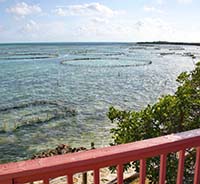
Shelling Along a Provo Beach
As the morning sun caresses the windblown sand along a deserted beach, its warming rays are refracted by hundreds of white objects that become more visible with each degree of the sun’s angle. For expert shell seekers, this expanding spectacle would be like a treasure hunter finding an ancient Spanish galleon overflowing with gold!
Though many varieties of shells are in the Turks and Caicos Islands (turksandcaicostourism.com), several species of conch shells are the most dominant. In fact, conch has always been an important part of life and survival in this tropical paradise. These huge sea snails are used as an ingredient in hundreds of delectable food dishes that are served in these islands. In modern times, however, conch has become important in jewelry-making, art work and as an exported food.
For those who might not understand the geography, the Turks and Caicos Islands are located at the far southeast corner of the Bahamas archipelago. These gems of the Atlantic Ocean are approximately 575 miles from Miami and are comprised of over 40 islands and uninhabited cays, including eight major islands: Grand Turk, Salt Cay, West Caicos, Providenciales, North Caicos, Middle Caicos, East Caicos and South Caicos. To the south, the Caicos Bank is a shallow, pale, turquoise sea that is partly composed of swamp and tidal flats that are filled with an abundant resource of conch, lobster and numerous species of fish. In this area, Sapodilla Bay is a popular mooring for yachts traveling through the Turks and Caicos Islands.

Rearing Pens at a Conch Farm
The most inhabited of all the islands and certainly the most visited is Providenciales, also known as “Provo.” It’s a wonderfully friendly place to visit and also home to conch farming. These mollusks with their beautiful pink shells take five years to grow to adult size.
Restaurant service and lodging throughout the islands is done on ‘Island Time’… which is somewhat slower and certainly more laid back than what most visitors expect. Nevertheless, the food, atmosphere and presentation seems to always be surprisingly unique in Provo.
Provo is also known as one of the premier destinations in the Caribbean for snorkeling, scuba diving, eco kayaking and fantastic bonefishing! Another interesting and educational trip is a stop at Little Water Cay, which is known to locals as “Iguana Island.” This small, unpopulated, arid spit of sand and vegetation is the home to more than 3,000 rare and endangered rock iguanas that are exclusive to the Turks and Caicos Islands. The trip should include an exploration of nearby Mangrove Cay and Big Water Cay as well.
From Provo, the full breadth of the Turks and Caicos Islands is open to enjoy and explore, including dozens of small uninhabited cays and sister islands, many of which are tropical wilderness land. Also known for its favorable year-round climate, the average Provo temperature is a balmy, breezy 78 degrees. Therefore, regardless of the season, these islands that dangle at the tip of the Bahamas chain like a shiny gold and turquoise pendant in the sun, are a joy to behold!
Photos: by Bill Vanderford




